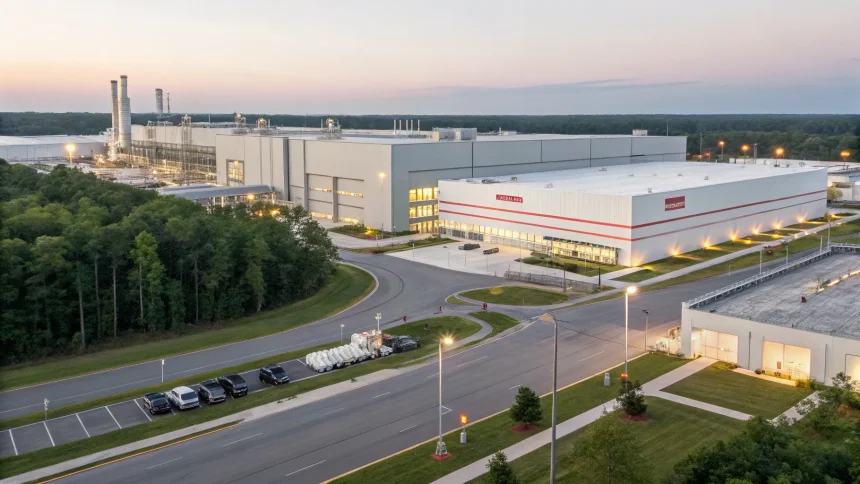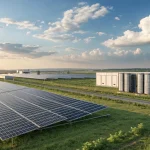Toyota has opened an electric vehicle battery plant in North Carolina, marking its first facility of this kind outside Japan. The move signals a deeper push into U.S. manufacturing as carmakers race to secure supplies for the next wave of electric and hybrid models. The plant, announced for North Carolina, positions the company closer to American assembly lines and federal incentives shaping the market.
“Toyota also announced the opening of an electric vehicle battery plant in North Carolina, its first such facility outside Japan.”
Why It Matters Now
The U.S. auto market is shifting, even if not at full sprint. Consumer interest in hybrids remains strong, and demand for battery-electric cars is uneven across regions. By building batteries domestically, Toyota can reduce shipping time, lower costs, and qualify for more local-content credits tied to federal policy. That improves pricing power and makes production schedules less fragile.
The timing also aligns with broader supply chain lessons from recent years. Companies have been bringing key parts closer to home to avoid shortages and freight spikes. Batteries are among the most expensive parts of an EV or hybrid, so local production can change the math.
What North Carolina Gains
The plant gives North Carolina another anchor in the auto supply chain. The state has been recruiting advanced manufacturing, offering workforce pipelines and infrastructure near major highways and rail links. Local officials have described battery production as a long-term jobs engine that can attract suppliers, from cathode materials to pack assembly.
Training programs at community colleges and universities are expected to feed technical roles needed to keep output steady and safe. Residents will watch the facility’s environmental record, including water use and recycling plans, which have become standard concerns with large battery sites.
Toyota’s Strategy: Hybrids First, Then More EVs
Toyota has leaned on hybrids for years and is doubling down as that segment grows. By adding a U.S. battery base, the company can scale hybrids and plug-in hybrids faster while preparing for more full EVs. Executives have argued that cutting emissions at volume today beats waiting for perfect charging coverage tomorrow.
Analysts say this approach hedges against mixed charging availability and cost-sensitive buyers. It also buys time for improvements in battery chemistry and for charging networks to expand in rural areas. If consumer demand for full EVs accelerates, local battery lines can be retooled or expanded more easily than starting from scratch overseas.
Supply Chain and Policy Tailwinds
Federal incentives encourage North American production and sourcing. Automakers that meet content rules can pass tax credits to buyers, lowering sticker shock. Building packs in the U.S. helps more models qualify, though mineral sourcing remains a hurdle for many brands.
On the logistics side, a North Carolina location puts Toyota within trucking distance of several assembly plants across the Southeast and Midwest. Shorter routes cut emissions from transport and reduce the risk of bottlenecks at ports.
Competition and Market Impact
Toyota joins a crowded field. U.S., European, and Asian brands have announced or opened battery plants across the South and Midwest. The collective build-out is reshaping regional economies and creating demand for engineers, electricians, and safety specialists.
For shoppers, more local supply should stabilize pricing and availability of hybrids and EVs. For utilities, the plant adds load to the grid and will likely come with agreements on energy use, peak demand, and a mix of renewable power. The choices made here will influence the plant’s carbon footprint and operating costs.
What To Watch Next
- Production ramp: pace of hiring and output targets in the first year.
- Model lineup: which Toyota and Lexus vehicles get the first U.S.-made packs.
- Supplier moves: announcements from materials and recycling partners near the site.
- Pricing effects: whether more models qualify for buyer credits under federal rules.
- Environmental metrics: energy mix, water use, and recycling rates.
The opening of Toyota’s North Carolina battery plant marks a practical step in reshoring key parts of the car industry and meeting policy demands with local jobs. It reflects a strategy built on hybrid strength now and flexibility for future EV growth. The early milestones to track are production stability, model eligibility for incentives, and how quickly suppliers cluster nearby. If those pieces fall into place, the plant could shape pricing and availability for years, giving Toyota a steadier hand in the U.S. market and giving North Carolina a durable industrial win.









